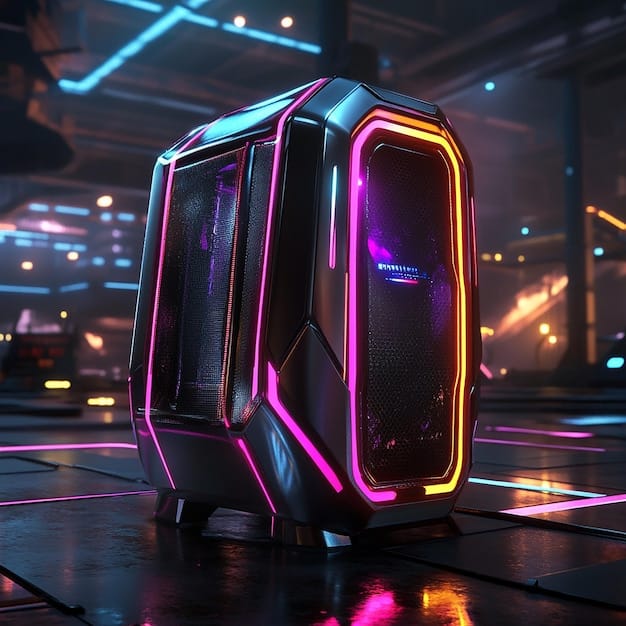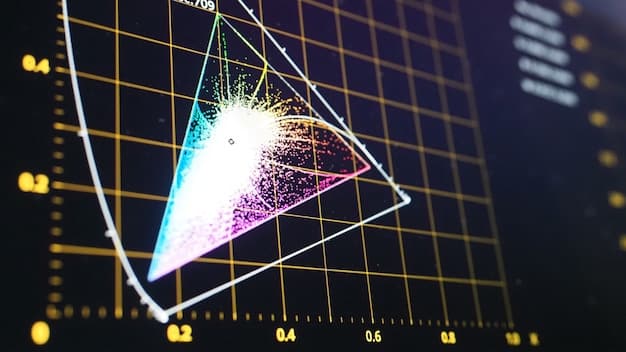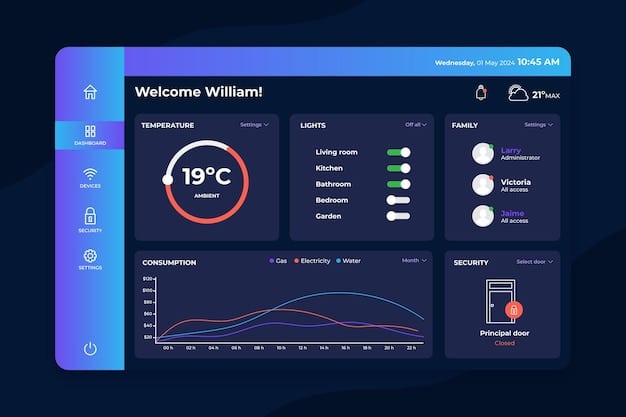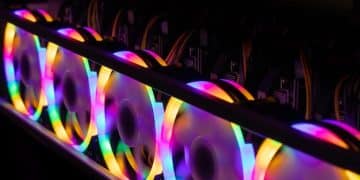Is Your Gaming PC Ready for 2025 Ray Tracing Revolution?

To determine if your gaming PC is ready for the 2025 ray tracing revolution, evaluate its GPU, CPU, and RAM against projected hardware requirements and conduct thorough benchmarking now to identify performance bottlenecks and ensure optimal visual fidelity in future titles.
The gaming landscape is constantly evolving, and a major shift is on the horizon. With 2025 fast approaching, the promise of widespread, truly immersive ray tracing is becoming a reality, pushing the boundaries of visual fidelity. The crucial question for every enthusiast becomes: Is your gaming PC ready for the 2025 ray tracing revolution? Benchmark your system now to avoid being left behind as games embrace incredibly realistic lighting, reflections, and shadows. Failing to prepare could mean missing out on the full, breathtaking experience developers are crafting.
The evolution of ray tracing in gaming
The journey of ray tracing in video games has been a fascinating one, evolving from a theoretical concept to a tangible, albeit demanding, reality. Initially, it was a feature exclusive to professional rendering applications, requiring immense computational power. Its integration into real-time gaming seemed like a distant dream, but advancements in GPU architecture, coupled with sophisticated software optimizations, have brought it to the forefront of modern game development. This technological leap has redefined what players expect from visual realism, moving beyond traditional rasterization techniques to simulate light behavior in a much more accurate and physically plausible manner.
From concept to consumer: a brief history
The first commercial introduction of real-time ray tracing in consumer hardware came with NVIDIA’s RTX series GPUs in 2018. This marked a pivotal moment, as it allowed gamers to experience advanced lighting effects that were previously impossible. Early implementations were often resource-intensive, leading to significant performance drops, even on high-end hardware. Developers had to carefully balance visual enhancements with playable frame rates, often resulting in hybrid rendering approaches where only certain elements benefited from ray tracing. However, this initial step paved the way for massive improvements, both in hardware capabilities and software optimization.
Over the past few years, we’ve seen a steady increase in the number of titles supporting ray tracing, alongside continuous performance improvements. AMD’s RDNA 2 and RDNA 3 architectures also brought competitive ray tracing capabilities, fostering innovation and competition in the GPU market. This healthy rivalry accelerated the development of more efficient ray tracing cores and improved drivers. Furthermore, upscaling technologies like DLSS (Deep Learning Super Sampling) and FSR (FidelityFX Super Resolution) became indispensable, allowing gamers to maintain high frame rates while enjoying graphically intensive ray-traced effects. These technologies act as crucial enablers, reconstructing high-resolution images from lower-resolution inputs, effectively mitigating the performance overhead of ray tracing.
The promise of 2025: what to expect
As we look towards 2025, the landscape for ray tracing is set to undergo another significant transformation. We anticipate a greater prevalence of “path tracing” – an even more advanced form of ray tracing that simulates light paths more comprehensively, leading to incredibly realistic global illumination, ambient occlusion, and reflections. This isn’t just about better visuals; it’s about creating game worlds that feel more natural and responsive to light, fundamentally altering how environments are perceived. Expect developers to integrate these techniques more deeply into their fundamental rendering pipelines, rather than as an optional overlay. This means that future game engines will be built from the ground up with ray tracing in mind, making it less of a performance burden and more of a standard feature.
* Ubiquitous Integration: Ray tracing will move from a niche feature to a standard for AAA titles.
* Path Tracing Dominance: More games will adopt full path tracing for ultimate realism.
* Hardware Optimization: Next-gen GPUs will feature even more powerful and efficient RT cores.
* Software Innovations: Further advancements in upscaling and other performance-boosting techniques.
The shift towards more comprehensive ray tracing, including path tracing, implies that the demands on your system’s hardware will continue to grow. It’s no longer enough to have a GPU that merely supports ray tracing; it needs to be powerful enough to render these complex lighting calculations efficiently and deliver smooth gameplay. This places a premium on top-tier graphics cards and robust processors that can handle the increased workload. The goal is to move beyond mere aesthetic enhancements to a point where lighting and shadows are fundamental to immersion, creating scenes that are indistinguishable from reality.
Understanding ray tracing’s hardware demands
Ray tracing is a computationally intensive technology that simulates the physical behavior of light, tracing individual rays from the viewer’s perspective back into the scene. This process generates incredibly realistic lighting, shadows, and reflections, but it comes at a significant hardware cost. Unlike traditional rasterization, which renders polygons and then applies textures and basic lighting, ray tracing dynamically calculates how light interacts with every surface. This requires specialized hardware and substantial processing power, making it a true test of a gaming PC’s capabilities.
The role of the GPU: more than just raw power
The graphics processing unit (GPU) is the undisputed powerhouse for ray tracing. While raw shader performance is important, ray tracing specifically benefits from dedicated RT (Ray Tracing) cores or equivalent hardware accelerators. Both NVIDIA’s RTX series and AMD’s Radeon RX 6000/7000 series GPUs feature these specialized cores designed to accelerate ray-triangle intersection tests and other ray tracing calculations. Without these, ray tracing becomes significantly slower, relying purely on general-purpose shaders, which are far less efficient for this task.
For 2025, a GPU with sufficient RT core count and advanced architecture will be crucial. Cards like NVIDIA’s RTX 40 series and AMD’s RX 7000 series are already showing strong performance in current ray-traced titles, but future games with more intensive path tracing implementations will further stress these components. The memory bandwidth and VRAM capacity of your GPU also play a critical role, as ray tracing involves processing vast amounts of geometric data and light paths. A GPU with at least 12GB of VRAM is quickly becoming the standard for high-resolution gaming with ray tracing enabled, and for 2025, 16GB or more will offer a comfortable buffer.

CPU and RAM implications: the unsung heroes
While the GPU handles the bulk of ray tracing computations, the CPU and RAM still play vital support roles. The CPU is responsible for managing game logic, physics, AI, and feeding instructions and data to the GPU. In graphically intensive scenarios, especially with complex ray-traced scenes, a weaker CPU can become a bottleneck, preventing the GPU from reaching its full potential. Modern games often involve complex scene management and dynamic object interactions that are exacerbated by ray tracing, necessitating a robust multi-core processor.
For 2025, an 8-core, 16-thread CPU (like an Intel Core i7/i9 or AMD Ryzen 7/9 from recent generations) should provide a solid foundation. These CPUs offer enough processing threads to handle game engines, background tasks, and all the data orchestration required for advanced rendering techniques. As for RAM, 16GB is currently the standard for high-end gaming, but 32GB is becoming increasingly beneficial, especially when running multiple applications or highly modded games alongside demanding ray-traced titles. Faster RAM (e.g., DDR5 with high clock speeds) also helps reduce latency between the CPU and GPU, ensuring data flows smoothly and efficiently.
* CPU Performance: A strong multi-core CPU prevents bottlenecks, ensuring steady data flow to the GPU.
* RAM Capacity: 16GB RAM is essential, 32GB is highly recommended for future-proofing.
* RAM Speed: Faster DDR4 or DDR5 memory helps overall system responsiveness.
Ultimately, a balanced system is key. A top-tier GPU paired with an underpowered CPU or insufficient RAM will result in suboptimal performance, even with ray tracing disabled. As 2025 approaches, games will become more sophisticated, demanding coordinated performance across all major components. Ensuring your CPU and RAM are capable of keeping up with your GPU’s ray tracing prowess is crucial for a smooth and enjoyable experience.
Essential benchmarking tools and practices
To truly understand if your gaming PC is ready for the 2025 ray tracing revolution, synthetic benchmarks and real-world game tests are indispensable. These tools provide objective data on your system’s performance, helping you identify bottlenecks and gauge its future-proofing. Relying solely on anecdotal experience or minimum system requirements can be misleading, as those often target basic functionality rather than optimal performance with advanced features like ray tracing.
Synthetic benchmarks: measuring raw power
Synthetic benchmarks are specialized programs designed to push your hardware to its limits and measure its performance in various scenarios. While they don’t perfectly replicate real-world gaming, they offer consistent, repeatable results that can be used for comparison and troubleshooting. For ray tracing, benchmarks like 3DMark Port Royal, 3DMark Speed Way, and Unigine Superposition are excellent starting points.
* 3DMark Port Royal: Specifically designed to test DirectX Raytracing performance, providing a score that directly reflects your GPU’s capabilities with ray-traced effects.
* 3DMark Speed Way: A newer DirectX 12 Ultimate benchmark that heavily utilizes ray tracing and other advanced features, giving a better indication of future performance.
* Unigine Superposition: Offers a good balance of traditional and advanced graphics rendering, with some ray-traced elements, useful for overall system stability and performance checks.
* UL Procyon’s Ray Tracing Benchmark: A more professional-grade benchmark that stresses specific ray tracing aspects.
When running these benchmarks, always ensure your system is stable, drivers are up to date, and background applications are minimized to get the most accurate results. Note down your scores and compare them against online databases or friends’ systems to get a sense of where your hardware stands. These scores will serve as a baseline for future upgrades or comparisons.
Real-world game benchmarks: the ultimate test
While synthetic benchmarks are informative, real-world game benchmarks provide the most relevant data for actual gaming performance. Many modern games include built-in benchmark tools that assess performance across various settings, including ray tracing. Games like Cyberpunk 2077, Control, Metro Exodus Enhanced Edition, and Alan Wake 2 are excellent choices, as they heavily utilize ray tracing and offer robust in-game benchmarks.
When conducting game benchmarks:
* Choose demanding titles: Focus on games known for their intensive ray tracing implementations.
* Test at your target resolution: If you game at 1440p or 4K, benchmark at those resolutions.
* Vary ray tracing settings: Test with ray tracing off, at medium, and at ultra settings to see the performance impact.
* Utilize upscaling technologies: Test with DLSS, FSR, or XeSS enabled at various quality presets to understand their benefits.
* Monitor key metrics: Use tools like MSI Afterburner or Rivatuner Statistics Server (RTSS) to monitor FPS, GPU utilization, CPU utilization, VRAM usage, and temperatures. Look for consistent frame rates, minimal stuttering, and healthy hardware temperatures.

Collect data consistently and analyze it to identify any potential weaknesses. A healthy system should maintain reasonable frame rates with ray tracing enabled, without consistently hitting 100% CPU utilization while the GPU idles, or vice versa. If you notice significant performance drops, excessive VRAM usage, or thermal throttling, these are indicators that your system might struggle with future ray-traced titles. The goal is to establish a performance baseline now, so you can track improvements or plan necessary upgrades as 2025 approaches and new, more demanding games are released.
Decoding your benchmark results
Once you’ve run your synthetic and real-world game benchmarks, the next crucial step is to interpret the data. Raw numbers alone don’t tell the full story; you need to understand what those numbers mean in the context of ray tracing and future gaming demands. This process involves evaluating frame rates, hardware utilization, and identifying potential bottlenecks that could hinder your experience when the 2025 ray tracing revolution hits its stride.
Frame rates and frame times: beyond FPS
The most obvious metric is frame rate (FPS), but it’s important to look beyond just the average FPS. While 60 FPS is often considered the gold standard for smooth gameplay, consistent frame delivery is equally, if not more, important.
* Average FPS: A good indicator of overall performance. For smooth ray-traced gaming in 2025, aiming for an average of 60 FPS at your target resolution with desired settings (including upscaling) is a strong goal.
* 1% Lows and 0.1% Lows: These metrics represent the lowest frame rates you experience during gameplay. Low 1% and 0.1% lows often indicate stutters and hitches, which can be far more disruptive to immersion than a slightly lower average FPS. Prioritize high 1% and 0.1% lows for a consistently smooth experience.
* Frame Times: Measured in milliseconds, frame times indicate how long it takes for each frame to render. Consistent, low frame times (e.g., below 16.6ms for 60 FPS) signify smooth gameplay, while erratic frame times point to stuttering and uneven frame delivery. Many benchmarking tools and overlays (like RTSS) can display frame time graphs; look for a flat, consistent line rather than jagged spikes.
If your 1% lows are significantly lower than your average FPS, or if your frame times are highly inconsistent, it suggests a performance bottleneck that isn’t always reflected in the average FPS. This could be due to CPU limitations, RAM issues, or even driver inefficiencies.
Hardware utilization: spotting bottlenecks
Monitoring GPU, CPU, and VRAM utilization during benchmarks is critical for identifying bottlenecks. This data tells you which component is working the hardest and which might be holding back the others.
* High GPU Utilization (95-99%): This is generally a good sign, indicating your GPU is working near its peak capacity and is the primary performance limiter. If you’re getting good frame rates here, your GPU is performing as expected.
* Low GPU Utilization (<90%) with Low Frame Rates: This often points to a CPU bottleneck. If your CPU is constantly at 100% utilization while your GPU is underutilized, it means the CPU can’t feed data to the GPU fast enough, limiting its potential.
* High CPU Utilization (near 100% across multiple cores): Can indicate a CPU bottleneck, especially if combined with low GPU utilization. Modern games, particularly those with complex physics or AI, can heavily tax the CPU.
* High VRAM Usage (near capacity): If your graphics card’s VRAM is constantly near its limit, it can lead to performance drops and texture pop-in as the system has to offload and reload textures from slower system RAM. For future ray-traced games, ensure your VRAM has enough headroom.
* Thermal Throttling: Monitor your GPU and CPU temperatures. If either component is consistently hitting high temperatures (e.g., above 85°C for GPU, above 90°C for CPU), it might be throttling its performance to prevent overheating, leading to reduced frame rates and instability. Ensure adequate cooling for your system.
By carefully analyzing these metrics, you can pinpoint exactly where your system might fall short for 2025’s ray tracing demands. A balanced system will show high GPU utilization and reasonable CPU utilization, with consistent frame times and healthy temperatures. Identifying a bottleneck allows you to make informed decisions about potential upgrades, ensuring you target the component that will provide the most significant performance improvement.
Optimizing your current setup for ray tracing
Even if your current hardware isn’t the absolute latest, there are several steps you can take to optimize your system for better ray tracing performance. These optimizations can significantly improve frame rates and visual fidelity without needing an immediate hardware upgrade, buying you time until the next generation of GPUs. A well-optimized system often performs better than a higher-spec, unoptimized one.
Driver updates and operating system tweaks
Keeping your drivers and operating system up to date is perhaps the simplest yet most effective way to ensure optimal performance. Both NVIDIA and AMD frequently release game-ready drivers that include performance optimizations and bug fixes specifically for new titles, including those with ray tracing.
* GPU Drivers: Always download the latest official drivers from NVIDIA’s or AMD’s website. Perform a “clean installation” to remove any old driver files that might cause conflicts.
* Windows Updates: Ensure your Windows operating system is fully updated. Microsoft often releases performance enhancements and API updates (like DirectX) that can benefit gaming.
* Game Mode: Enable Windows Game Mode (Settings > Gaming > Game Mode) to optimize your PC for gaming by prioritizing game processes.
* Hardware-accelerated GPU scheduling: (Windows 10/11, Settings > System > Display > Graphics Settings) can sometimes improve performance by offloading scheduling duties from the CPU to the GPU. Test this feature, as results can vary.
* Shader Cache: Ensure your GPU driver settings have an adequate shader cache size. This helps stored shader compilations, reducing CPU overhead and loading times.
These software optimizations can often provide a noticeable boost, especially in games that have recently received compatibility updates for specific hardware. Always do a quick test after major driver updates to ensure stability.
In-game settings and upscaling technologies
The right in-game settings can make a huge difference in ray tracing performance. It’s often a balancing act between visual quality and frame rate, but modern upscaling technologies offer a great way to have both.
* Ray Tracing Settings: Many games offer different levels of ray tracing (e.g., low, medium, high, ultra). Experiment with these settings. Often, the visual difference between “high” and “ultra” ray tracing is minimal, but the performance impact can be substantial. Start with medium and gradually increase until your frame rate drops below your comfort zone.
* Upscaling Technologies (DLSS/FSR/XeSS): These are your best friends for ray tracing. Technologies like NVIDIA’s DLSS, AMD’s FSR, and Intel’s XeSS render the game at a lower resolution and then use AI or advanced algorithms to upscale it to your native display resolution. This significantly reduces the performance hit of ray tracing while maintaining near-native image quality.
* DLSS (Deep Learning Super Sampling): Requires NVIDIA RTX GPUs. Offers various quality modes (Quality, Balanced, Performance, Ultra Performance).
* FSR (FidelityFX Super Resolution): Open-source, works on a wider range of GPUs (AMD, NVIDIA, Intel). Also offers multiple quality modes.
* XeSS (Xe Super Sampling): Intel’s competing technology, also open-source and compatible with many GPUs.
Always enable one of these upscaling technologies when playing ray-traced games, especially at higher resolutions. Start with the “Quality” mode and adjust as needed. The performance gains can be 30-50% or even higher, transforming an unplayable experience into a smooth one. Remember that game settings like ambient occlusion, shadows, and reflections often have separate ray tracing options; tweaking these individually can yield better results than simply hitting a global “ultra” preset.
Future-proofing your rig: upgrade considerations
The thought of upgrading a gaming PC can be daunting, but with the 2025 ray tracing revolution on the horizon, it’s a necessary discussion. Understanding which components will offer the most significant impact on your ray tracing performance is key to making smart, cost-effective decisions. Blindly upgrading parts without a clear strategy can lead to wasted money and minimal performance gains.
When to upgrade your GPU
Your graphics card is the single most important component for ray tracing. If your current GPU significantly underperforms in ray-traced benchmarks, or if it lacks dedicated RT cores (e.g., older GTX series cards), a GPU upgrade is likely your top priority.
Consider upgrading your GPU if:
* Your average FPS in ray-traced games is consistently below 60 FPS (or your target refresh rate) even with upscaling enabled.
* Your GPU utilization is consistently at 100% with low frame rates, indicating it’s the primary bottleneck.
* Your GPU has less than 10-12GB of VRAM if you game at 1440p or 4K with ray tracing.
* You’re using an older generation GPU (e.g., pre-RTX 20 series or pre-RX 6000 series) that lacks sufficient RT hardware.
When choosing a new GPU, prioritize models from the latest generations (e.g., NVIDIA RTX 40 series, AMD RX 7000 series) that offer improved RT core performance and increased VRAM. These cards are specifically designed to handle the demands of future ray-traced and path-traced titles more efficiently.
CPU, RAM, and storage: secondary but vital upgrades
While the GPU leads the charge, your CPU, RAM, and storage play crucial supporting roles that become more significant with complex game engines and ray tracing.
* CPU: If your benchmark results showed a CPU bottleneck (low GPU utilization with high CPU utilization), an upgrade here is necessary. Look for modern CPUs with high core counts (6-8 cores minimum for gaming) and strong single-core performance. Intel’s Core i5/i7/i9 or AMD’s Ryzen 5/7/9 from recent generations are excellent choices. A CPU upgrade might also necessitate a new motherboard and RAM if you’re jumping generations (e.g., from DDR4 to DDR5).
* RAM: If you’re running 8GB or even 16GB of slower DDR4 RAM, upgrading to 32GB of faster DDR4 (3200MHz+) or DDR5 RAM (5600MHz+) can improve overall system responsiveness and prevent stutters, especially in memory-intensive games or with multiple background applications.
* Storage: While not directly impacting ray tracing calculations, faster storage (NVMe SSDs) significantly reduces game loading times and improves texture streaming performance. This can contribute to a smoother overall experience and reduce “stuttering” as game assets are loaded. If you’re still on an HDD or SATA SSD, upgrading to a modern NVMe drive is a worthwhile investment.
Remember, a balanced system is key. If you have an incredibly powerful GPU but an outdated CPU, you won’t get the full benefit of your new graphics card. Evaluate your benchmark results holistically and prioritize upgrades that address the weakest links in your system to maximize your investment for the 2025 ray tracing revolution.
Best practices for maintaining peak performance
Beyond initial setup and upgrades, consistent maintenance is crucial for ensuring your gaming PC continues to deliver peak performance well into the 2025 ray tracing era. A well-maintained system will not only perform better but also last longer, protecting your investment in high-end hardware. Neglecting simple maintenance tasks can lead to performance degradation, overheating, and system instability over time.
Keeping your system cool and clean
Heat is the enemy of performance. Components like GPUs and CPUs generate a lot of heat, especially when running demanding tasks like ray tracing. Proper cooling and a clean system are essential to prevent thermal throttling and extend component lifespan.
* Dust Management: Regularly clean your PC’s interior to remove dust buildup from fans, heatsinks, and vents. Dust acts as an insulating layer, trapping heat. Use compressed air to blow out dust from CPU coolers, GPU fins, and case fans. Aim for a cleaning schedule every 3-6 months, or more frequently if you live in a dusty environment or have pets.
* Airflow Optimization: Ensure your PC case has good airflow. This means having an effective intake and exhaust fan setup. Research positive or negative pressure setups for your specific case to optimize cooling. Make sure cables are neatly routed to avoid obstructing airflow.
* Thermal Paste: Consider reapplying thermal paste on your CPU and GPU (if you’re comfortable with the process or have a professional do it) every few years. The stock thermal paste can dry out and become less effective over time.
* Monitoring Temperatures: Use software like HWMonitor, MSI Afterburner, or NZXT CAM to keep an eye on your CPU and GPU temperatures during gaming sessions. If temperatures consistently run high (e.g. above 85°C for GPU or 90°C for CPU), investigate potential cooling issues.
A cool, clean system runs more efficiently and reliably, ensuring that your hardware can deliver its advertised performance without throttling. This is particularly important for ray tracing, as it pushes GPUs to their thermal limits.
Software hygiene and background processes
Just as crucial as hardware maintenance is maintaining a clean and efficient software environment. A cluttered operating system with too many background processes can drain resources and impact gaming performance.
* Minimize Background Applications: Before launching a demanding game, close unnecessary applications, web browser tabs, and background processes. Even seemingly innocuous programs can consume CPU cycles and RAM.
* Startup Programs: Disable non-essential programs from launching at Windows startup. You can manage this through the Task Manager (Ctrl+Shift+Esc > Startup tab).
* Disk Cleanup: Regularly run Windows Disk Cleanup or a similar third-party tool to remove temporary files, old downloads, and other junk files that accumulate over time.
* Antivirus Software: Ensure your antivirus is up to date and performing scheduled scans. However, try to avoid running full scans while gaming. Many modern antivirus programs have “gaming modes” that reduce their impact during gameplay.
* Defragmentation (for HDDs): If you still use a traditional Hard Disk Drive (HDD) for storage, defragment it regularly. This is not necessary for SSDs, as they work differently.
* Regular Restarts: A simple restart can often resolve minor performance issues by clearing RAM and resetting processes. Make it a habit to restart your PC regularly rather than just putting it to sleep.
By adhering to these best practices, you create a lean, mean, gaming machine that is always ready to tackle the latest challenges, including the demanding visual feasts promised by the 2025 ray tracing revolution. Proactive maintenance ensures your system remains responsive, stable, and capable of delivering the immersive experiences you expect.
Navigating the 2025 ray tracing landscape
As the gaming industry charges towards 2025, the proliferation of advanced ray tracing techniques will redefine visual standards. This revolution won’t just introduce prettier graphics; it will fundamentally change how developers design game worlds and how players interact with them. Understanding this evolving landscape is essential for gamers who wish to stay ahead of the curve and fully embrace the immersive experiences that lie ahead.
The transition to more pervasive ray tracing is not a sudden leap but a continuous evolution. By 2025, game engines will likely have further optimized their rendering pipelines to natively support complex light simulations, moving beyond the current hybrid approaches. This means lower performance overheads for developers and more consistent, high-quality visuals for players. Expect to see ray tracing not just for reflections and shadows, but meticulously integrated into global illumination systems, volumetric effects, and even realistic material properties, making environments feel truly dynamic and alive.
One significant aspect of this future landscape will be the continued importance of upscaling technologies. As ray tracing becomes more intricate, even the most powerful hardware will benefit from techniques like DLSS, FSR, and XeSS to maintain high frame rates at native resolutions. These solutions will evolve, likely becoming even more sophisticated and ubiquitous, minimizing the visual compromises while maximizing performance. Gamers should continue to embrace these technologies as key enablers for the best possible experience.
Furthermore, the rise of more efficient hardware will also play a crucial role. Next-generation GPUs, beyond 2025, will likely feature significantly improved RT cores, potentially integrating them more deeply into the shader pipeline. This architectural shift could make ray tracing performance almost on par with traditional rasterization, making it a “default on” setting rather than a performance-intensive option. This will lower the barrier to entry for experiencing full ray tracing, making it accessible to a wider range of hardware configurations.
In essence, the 2025 ray tracing revolution will mark a tipping point where these advanced lighting techniques move from being a premium feature to an expected standard. For gamers, this means a richer, more immersive visual experience across the board. By benchmarking your system now, understanding your results, and strategically planning for future upgrades and optimizations, you ensure that you are not just watching the revolution unfold, but actively participating in it, enjoying every ray-traced reflection and shadow in its full glory.
| Key Point | Brief Description |
|---|---|
| 💡 Ray Tracing Evolution | By 2025, expect widespread path tracing and deeper integration into game engines for ultimate realism. |
| 🖥️ Hardware Demands | Requires powerful GPUs with dedicated RT cores, strong multi-core CPUs, and 16GB+ fast RAM for optimal performance. |
| 📈 Benchmarking Now | Use synthetic and in-game benchmarks to assess current system capabilities and identify bottlenecks, especially with ray tracing settings. |
| ⚙️ Optimization & Upgrades | Keep drivers updated, utilize upscaling (DLSS/FSR), and strategically upgrade GPU, CPU, or RAM based on benchmark analysis. |
Frequently asked questions about ray tracing readiness
Ray tracing is an advanced rendering technique that simulates the physical behavior of light, tracing individual light rays to create ultra-realistic lighting, shadows, and reflections. It’s demanding because it performs complex calculations for each light ray’s interaction with every object in a scene, requiring specialized hardware acceleration found in modern GPUs.
For 2025, GPUs from recent generations like NVIDIA’s RTX 30 series (especially 3070 Ti and above) and RTX 40 series, or AMD’s RX 6000 series (6800 XT and above) and RX 7000 series, are generally considered “ready.” The higher-end models from these series will offer the best experience due to more powerful RT cores and higher VRAM.
Absolutely, upscaling technologies like NVIDIA’s DLSS, AMD’s FSR, and Intel’s XeSS are crucial for enabling playable frame rates with ray tracing. They render the game at a lower resolution and intelligently upscale it, reducing the performance hit while maintaining high visual quality. Always enable one of these when playing ray-traced titles.
While the GPU is primary, a strong multi-core CPU (e.g., 8 cores/16 threads) is essential to prevent bottlenecks, managing game logic and feeding data efficiently. Sufficient and fast RAM (16GB minimum, 32GB recommended) also helps with system responsiveness and asset streaming within memory-intensive, ray-traced environments.
Focus on consistent average FPS (aim for 60+), high 1% and 0.1% lows to indicate smooth gameplay, and moderate frame times. Monitor GPU utilization (should be high) and CPU utilization (avoid 100% across all cores if GPU is underutilized). High VRAM usage or thermal throttling are also key indicators of potential issues.
Conclusion
The road to the 2025 ray tracing revolution is paved with stunning visuals and technological advancements, but also with increasing hardware demands. By taking the proactive step of benchmarking your system now, you gain invaluable insight into its current capabilities and limitations. Understanding your GPU’s ray tracing prowess, ensuring your CPU and RAM aren’t creating bottlenecks, and applying strategic optimizations and potential upgrades will guarantee you’re not just ready for the future, but actively immersed in it. Future-proofing your rig isn’t about having the absolute latest components; it’s about making informed decisions to ensure your gaming experience remains vibrant, smooth, and visually spectacular.





